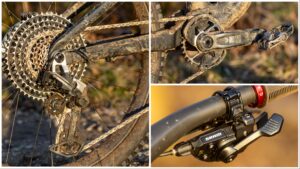One of the most innovative bikes we’ve ridden this year.
Zerode Taniwha (2017) first ride
With its wide-ratio Pinion gearbox, the Zerode Taniwha enduro rig marries innovation to aesthetics. Superlative suspension, excels on rough terrai.
Zerode Taniwha need to know
- Gearbox-only carbon-framed enduro bike
- Pinion 12spd gearing with 600% range
- Fox Factory suspension and 160mm travel

Zerode Taniwha: radical enduro rig with a downhill bent
Zerode Taniwha review
The Zerode is one of the most innovative bikes we’ve ridden this year.
It’s a 160mm travel enduro bike, complete with carbon frame and 27.5in wheels designed exclusively for use with a Pinion gearbox. There’s no rear mech option, no compromise around the frame to adapt to a traditional drivetrain and no hedging of bets for anyone not interested in this new propulsion system.
It’s a bold move and it makes for a truly beautiful bike, sleek because the gearbox isn’t just bolted onto the BB shell. There are clean lines everywhere, internal routing, stealth black paintwork and a single-pivot suspension design.

Pinion gearbox offers 600 per cent gear range over 12 ratios
Riding the Zerode is a steep learning curve because the gearbox is like nothing you’ve ever ridden before — you have to learn how to change gear all over again.
There’s no shifting when you’re putting any kind of pressure through the pedals, meaning you have to think carefully about the gear you need before attacking a climb.
There’s a massive 600% gear range delivered through 12 gears though, and — much to my surprise — the Taniwha doesn’t feel overly weighty for a 160mm travel enduro bike, thanks to its carbon frame. Zerode estimates the bike weighs about 800g more with the gearbox than it would with a standard transmission.

Lighter rear end aids suspension
There are clear advantages to changing gear when you’re not pedalling — dropping into switchbacks or pinballing along trails where a pedal strike could send you flying off into the bushes. Overall there are gains and losses to gearbox shifting, but shifting the derailleur habits of a lifetime proved tricky for me.
Zerode’s background is in downhill — the first production bike produced was a gearbox-driven bike with 210mm travel — so it’s no surprise the Taniwha shines brightest when descending.

Super-sensitive Fox Float X EVOL with 160mm travel
The suspension is extremely sensitive, sucking up rough ground so easily and comfortably I had to check I’d put enough air in the tyres, and there’s enough travel here to cope with big hits too.
Ditching the unsprung mass of a cassette and derailleur and increasing the sprung mass with a gearbox turns the Taniwha into a mini downhill bike.
Backing up the silky smooth suspension is a solid platform of stiff frame and relaxed geometry that cries out to be thrown down proper mountains or at least bike parks with black runs.

Gripshifters do the Taniwha no favours
Going downhill the Taniwha felt like a bike I’d love to ride more, if it wasn’t for one particularly irritating feature. The excess weight I can live with, the new shifting patterns I can learn, but I’d never got on with the grip shift gear changes.
Braking and shifting at the same time is impossible, while rolling your wrist over the bar to change gear messes with your body position.
With a conventional shifter the Taniwha could be a brilliant enduro weapon, but the gripshift blunts its edge.

















